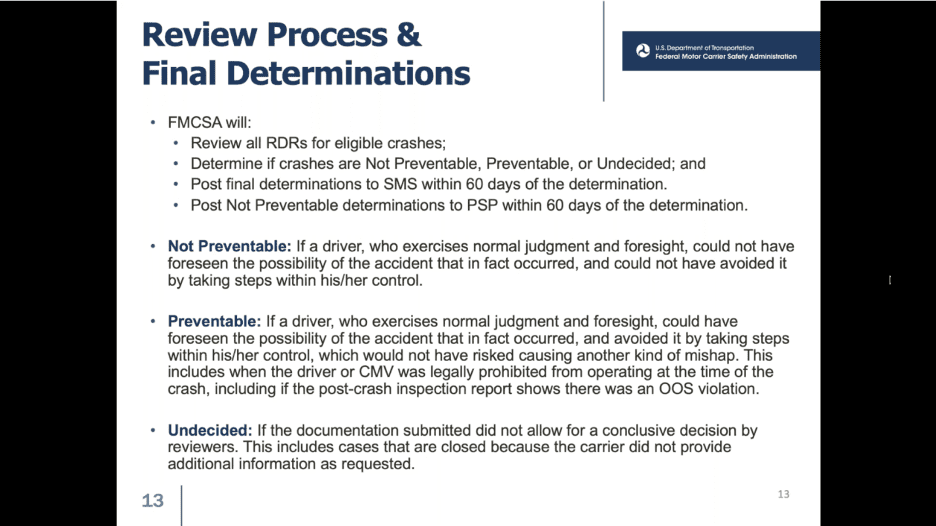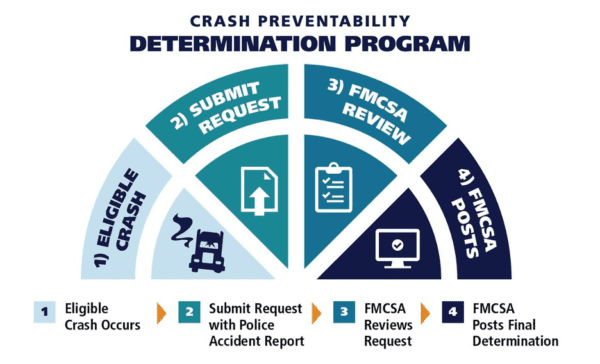Webinar Takeaways: FMCSA Crash Preventability Determination Program
During a recent webinar hosted by the National Waste & Recycling Association, Theresa Rowlett and Catterson Oh of the Federal Motor Carrier Safety Administration (FMCSA) provided an overview of the FMCSA Crash Preventability Determination Program (CPDP). The program, which began as a demonstration program and recently expanded with more types of eligible crashes, a modified Safety Measurement System (SMS) and an updated Pre-Employment Screening Program (PSP), allows carriers and drivers to submit evidence that an eligible crash was not preventable.
Under the new program, which began on May 1, carriers and drivers can submit evidence of eligible crashes that occurred on or after August 1, 2019. Requests for Data Review (RDR) submissions uploaded through the agency’s DataQs website should include the required police accident report as well as other supporting documents such as photos, videos, insurance documents and drug and alcohol test results for fatal crashes.
Once an RDR is submitted, FMCSA will review the request and determine if the crash is not preventable, preventable or undecided. If the crash is determined not preventable, it will be listed on the SMS but not included when calculating a carrier’s Crash Indicator Behavior Analysis and Safety Improvement Category measure in SMS. Additionally, the not preventable determinations will be noted on a driver’s PSP report.

If the crash received a final preventability determination from a closed investigation, the determination program will adopt the investigation’s determination. The determination program will not review preventable or undecided crashes reviewed by an FMCSA safety investigator during an investigation; these requests will be closed.
If a motor carrier wants the crash reviewed for preventability after an investigation or audit is closed, for the purpose of changing a safety rating, the motor carrier will be required to pursue an administrative review as set forth in 49 CFR section 385.15.
The new program has received more than 3,000 submissions to date and includes various additions to its eligibility guidelines. Wondering if your crash is eligible for the program? Check out the updated list of eligible crash types below:
Struck in the Rear type of crash when the CMV was struck:
- in the rear; or
- on the side at the rear.
Wrong Direction or Illegal Turns type of crash when the CMV was struck:
- by a motorist driving in the wrong direction; or
- by another motorist in a crash when a driver was operating in the wrong direction; or
- by a vehicle that was making a U-turn or illegal turn.
Parked or Legally Stopped type of crash when the CMV was struck:
- while legally stopped at a traffic control device (e.g., stop sign, red light or yield); or while parked, including while the vehicle was unattended.
Failure of the other vehicle to Stop type of crash when the CMV was struck:
- by a vehicle that did not stop or slow in traffic; or
- by a vehicle that failed to stop at a traffic control device.
Under the Influence type of crash when the CMV was struck:
- by an individual under the influence (or related violation, such as operating while intoxicated), according to the legal standard of the jurisdiction where the crash occurred; or
- by another motorist in a crash where an individual was under the influence (or related violation such as operating while intoxicated), according to the legal standard of the jurisdiction where the crash occurred.
Medical Issues, Falling Asleep or Distracted Driving type of crash when the CMV was struck:
- by a driver who experienced a medical issue which contributed to the crash; or
- by a driver who admitted falling asleep or admitted distracted driving (e.g., cellphone, GPS, passengers, other).
Cargo/Equipment/Debris or Infrastructure Failure type of crash when the CMV:
- was struck by cargo, equipment or debris (e.g., fallen rock, fallen trees, unidentifiable items in the road); or crash was a result of an infrastructure failure.
Animal Strike type of crash when the CMV:
- struck an animal
Suicide type of crash when the CMV:
- struck an individual committing or attempting to commit suicide
Rare or Unusual type of crash when the CMV:
- Was involved in a crash type that seldom occurs and does not meet another eligible crash type (e.g., being struck by an airplane or skydiver or being struck by a deceased driver).
For more information, check out this FAQs document and listen to this recording of the webinar.

